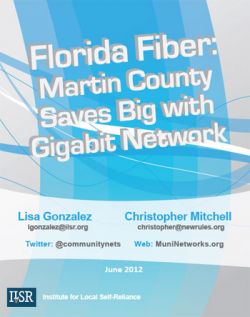Image


 This is the present plan, as far as we can tell. Rather than paying Comcast its inflated rates to lease services, the County is paying MFE to build a network that will connect public facilities and be owned by the County. St Paul will lease capacity from that network. In building the County's network, MFE will build its own network right next to the County at the same time. The County will serve community anchors (schools, police, fire, etc.) and MFE will offer dark fiber to everyone else.
Comcast, which apparently viewed itself as the sole legitimate supplier of broadband to local government, has freaked out. As noted in a Pioneer Press article on the network:
This is the present plan, as far as we can tell. Rather than paying Comcast its inflated rates to lease services, the County is paying MFE to build a network that will connect public facilities and be owned by the County. St Paul will lease capacity from that network. In building the County's network, MFE will build its own network right next to the County at the same time. The County will serve community anchors (schools, police, fire, etc.) and MFE will offer dark fiber to everyone else.
Comcast, which apparently viewed itself as the sole legitimate supplier of broadband to local government, has freaked out. As noted in a Pioneer Press article on the network:
"City and county taxpayers are facing significant risk by being put in a position of competing directly with many well-established service providers," said Mary Beth Schubert, a vice president of corporate affairs with Comcast in the Twin Cities.Comcast is in the midst of creating a tempest in a teapot. And since it basically owns the St Paul Chamber of Commerce, the Chamber is helping. In two different articles, the Pioneer Press has printed Comcast's absurd comparison of this project with UTOPIA. For those unfamilar, UTOPIA is a consortium of Utah cities that planned to build a $500,000,000 network to connect 500,000 residents and businesses with the most advanced broadband network on the planet. The Ramsey/St Paul plan will connect over one hundred municipal facilities with broadband at a cost of between $10 million and $25 million. You say tomato, I say world's largest pumpkin. No comparison. I don't know why the Pioneer Press lets Comcast get away with these exaggerations, but I wish it would at least result in future fact checking of such comments to see just how much manure they contain. With regard to Comcast's chief objection, neither the City nor the County will be competing with the private sector. The City and County are serving themselves. It is MFE that could be said to be competing with Comcast (though Comcast typically refuses to lease dark fiber in favor of overcharging customers for lit services). Comcast's objection should be considered the same way we would laugh at Starbucks for claiming the County's coffee pots are an affront to the free market.
 The City and County have made a business decision that owning their own network will result in cost savings to taxpayers and a better level of service. This is unsurprising and in line with what we have seen elsewhere, most recently documented in Florida's Martin County, where transitioning away from Comcast is saving millions of dollars.
Martin County is not an isolated case. We previously wrote of Comcast's onerous rate hikes for Palo Alto's I-Net in 2009. We have seen the same story play out in city after city - where Comcast dramatically increases the fees for community anchor institutions, recognizing that most local governments have few alternatives. One of the most impressive such networks is DC-Net, operated by the local government. As we noted in a report years ago, DC-Net saves the community over $5 million each year (real costs compared to the costs of duplicating those services by leasing from existing carriers).
Our case studies detailing how three communities built the fastest and most affordable networks in the nation notes that one saved more than $1 million by transitioning from leased lines to its own. Another dramatically increased capacity to schools and libraries while holding the price constant or decreasing it.
The City and County have made a business decision that owning their own network will result in cost savings to taxpayers and a better level of service. This is unsurprising and in line with what we have seen elsewhere, most recently documented in Florida's Martin County, where transitioning away from Comcast is saving millions of dollars.
Martin County is not an isolated case. We previously wrote of Comcast's onerous rate hikes for Palo Alto's I-Net in 2009. We have seen the same story play out in city after city - where Comcast dramatically increases the fees for community anchor institutions, recognizing that most local governments have few alternatives. One of the most impressive such networks is DC-Net, operated by the local government. As we noted in a report years ago, DC-Net saves the community over $5 million each year (real costs compared to the costs of duplicating those services by leasing from existing carriers).
Our case studies detailing how three communities built the fastest and most affordable networks in the nation notes that one saved more than $1 million by transitioning from leased lines to its own. Another dramatically increased capacity to schools and libraries while holding the price constant or decreasing it.
 Local governments and communities have an interest in building networks to spur economic development, create more choices for consumers, and otherwise improve the quality of life. Private companies have one mission - to profit. And while the profit motive is an incredibly important force, it is the wrong one to drive decisions about essential infrastructure.
These networks are increasingly the basis for much of the economy. We don't let GM and Ford make the rules for what cars are allowed on the roads and we shouldn't encourage a few companies to rule our access to the Internet.
So What Should We Do? First of all - we need more information. We need to see this contract and have a chance to comment on it before the City and County have made their final decisions. Some of those giving technical advice to St Paul were involved in the wretched Minneapolis Wi-Fi contract. Promises were made, particularly in regard to a digital divide fund -- but the contract was poorly written and that fund has all but disappeared. Our plan should be vetted by actual experts.
Our local governments should revisit the 2007 St Paul plan and the goal of building infrastructure that really enables more choices for local businesses and residents. In the telecommunications regulatory environment, local governments have few tools to ensure competition. The strongest one is their own procurement decisions -- they should be building one network and they should control it. If leasing dark fiber fails to create sufficient competition, they can change course. But if MFE's plan fails to encourage competition, local governments can do nothing but watch and hope for the best because MFE calls the shots on its network.
The City and County should have developed a telecommunications plan (at less cost than they have paid to develop this ho-hum approach) that would enable them to put conduit and fiber in the ground for essentially no cost over the past 5 years during other projects (when a road is already open for other construction, putting fiber and conduit in is trivial). Better late than never - get this process started.
Local governments and communities have an interest in building networks to spur economic development, create more choices for consumers, and otherwise improve the quality of life. Private companies have one mission - to profit. And while the profit motive is an incredibly important force, it is the wrong one to drive decisions about essential infrastructure.
These networks are increasingly the basis for much of the economy. We don't let GM and Ford make the rules for what cars are allowed on the roads and we shouldn't encourage a few companies to rule our access to the Internet.
So What Should We Do? First of all - we need more information. We need to see this contract and have a chance to comment on it before the City and County have made their final decisions. Some of those giving technical advice to St Paul were involved in the wretched Minneapolis Wi-Fi contract. Promises were made, particularly in regard to a digital divide fund -- but the contract was poorly written and that fund has all but disappeared. Our plan should be vetted by actual experts.
Our local governments should revisit the 2007 St Paul plan and the goal of building infrastructure that really enables more choices for local businesses and residents. In the telecommunications regulatory environment, local governments have few tools to ensure competition. The strongest one is their own procurement decisions -- they should be building one network and they should control it. If leasing dark fiber fails to create sufficient competition, they can change course. But if MFE's plan fails to encourage competition, local governments can do nothing but watch and hope for the best because MFE calls the shots on its network.
The City and County should have developed a telecommunications plan (at less cost than they have paid to develop this ho-hum approach) that would enable them to put conduit and fiber in the ground for essentially no cost over the past 5 years during other projects (when a road is already open for other construction, putting fiber and conduit in is trivial). Better late than never - get this process started.
